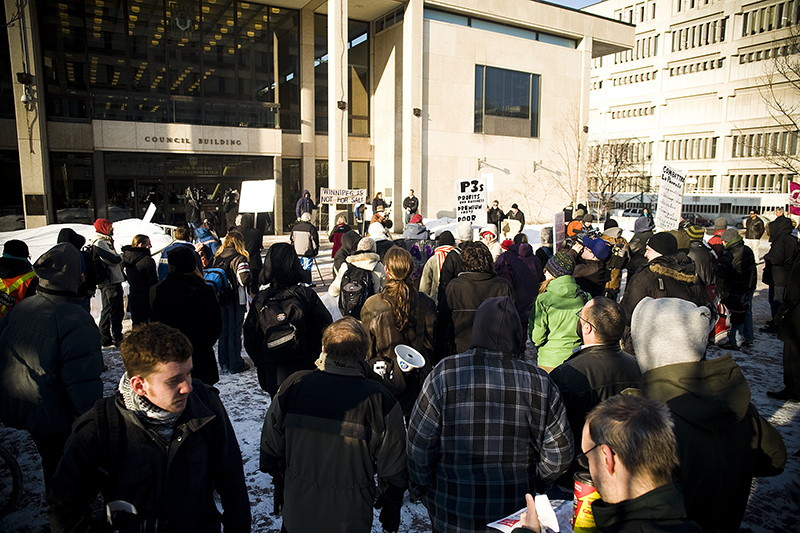The Soft Parade
Protesters discuss the pros and cons of parade by-laws
Winnipeg’s parade by-law is being taken to task by three protesters who were arrested for parading without a permit in conjunction with a demonstration held on Sept 17, 2012. “Why should we need permission from the Chief of Police to peacefully assemble? If a peaceful assembly is a fundamental freedom in Canada, why would you need to pay a fee for permission to do that?” asks their lawyer, Ian Histed.
Histed plans to use challenge by-law 1573/77 (commonly referred to as the City of Winnipeg Traffic By-law) on a constitutional basis. “The by-law is an unreasonable restriction of the right to peacefully assemble” - in accordance with section 2C of the Charter of Rights and Freedoms - Histed asserts.
Under the current by-law, a parade is defined as a group of more than 30 people (or more than 10 vehicles). Protests are listed as one sub-type of parades, and all parades require a permit.
Louise May, one of the defendants, isn’t opposed to issuing permits for parades, but does take issue with the discretionary nature of issuing permits for protests. “If it’s discretionary, then the police can choose either to say no, if they don’t want that protest to happen, or they can limit it [..] so it can’t be as visible, so those choice become political,” May says.
While the by-law itself requires 48 hours notice for a permit request, a permit application guide posted on the City of Winnipeg website requests at least two weeks’ notice.
Patrol Sergeant Kevin Cisaroski states that the permit system operates on a first-come-first-served basis, and that the Winnipeg Police Service requests two weeks’ notice in order to allocate police escort resources effectively. Cisaroski believes that the permit system is a matter of public safety.
“Without [a permit], the group is putting themselves and all of their participants in [..] great possibility of danger as they’re walking down the roadway without any kind of visible police presence,” Cisaroski states.
This risk has been mitigated thus far by police response, as “our police still end going to provide that assistance [of an escort]” to unauthorized parades, but that these events pull police resources away from “possibly higher priority policing duties,” according to the Sergeant.
Cisaroski states that he makes no distinction between parades or protests while issuing permits on behalf of the Chief of Police, and doesn’t see the permit application process as a barrier to public assembly.
“Just because there’s a process involved doesn’t mean that it’s unwieldy. If they want to conduct their protest [without a permit], they can still do it, it just means that they may not be able to do it by walking down the middle of a roadway,” he states.
Cisaroski suggested that protesters could voice their concerns in alternate locations, such as in a park, at the Legislative building, or on the sidewalk, if accessing a permit doesn’t work out for them.
According to Histed’s reading of the bylaw, permits are still required even if protesters are not using the street: “[Y]ou need a parade permit even if you’re parading on the sidewalk as well [..] the police take the position that if you’re going to parade on the street, you need a police escort but if you’re going to parade on the sidewalk you don’t. But the parade bylaw doesn’t say that, the parade bylaw says that you need a permit period.”
While any person involved in a parade that hasn’t been issued a permit could be charged with parading without a permit under the bylaw, enforcement isn’t always consistent, according to Histed. Participants may have “no way of predicting when [their] conduct would attract the attention of the police.”
To some, the enforcement of this bylaw might seem fairly random, as some spontaneous parades or protests have been allowed to run their course without any charges being laid, while others have not. Histed acknowledges that seemingly “random and arbitrary” enforcement is not a defense for a charge, though he does consider this to be a persistent issue.
In the instance of the September 2012 protest, “the police seemed to have suddenly come upon it and decided ‘oh, you can’t do this’, but it’s not even clear that they checked to see whether there was a permit first,” Histed states.
Patrol Sergeant Cisaroski asserts that it is an individual’s responsibility to know the laws in order to avoid being charged for joining a parade.
“The bylaw doesn’t specify organizers only, it requires all participants to know. It’s like any law [..] people are expected to know the laws [..] there is a law that requires participants in a parade to obtain a parade permit and if they’re participating in a parade, on a roadway, without the permit, then they are subject to prosecution.”
While there may be differing opinions on how the bylaws are interpreted and enforced, the full text of the Traffic bylaw is available to read and download at the City of Winnipeg’s website. Though the full text runs 43 pages, the sections affecting parades take up little more than a page and a half.
At the very least, May hopes that through these charges, an opportunity will arise to discuss these bylaws, especially in light of recent tensions between protesters and police in Montreal. “There’s no other forum to have that discussion”, May says. “That’s why this court challenge is important, to redirect the energy and make sure that we’re community building, including with the Winnipeg Police Service [..] not hurting our communities. I have more hope that what’s happening in Quebec, [I’m] more hopeful than that.”
Published in Volume 68, Number 26 of The Uniter (May 7, 2014)







